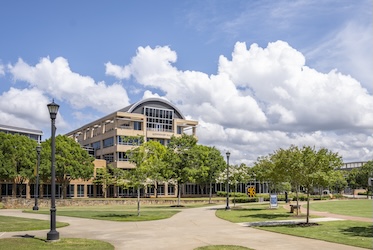

KENNESAW, Ga. | Jul 19, 2021

Kennesaw State University continues to represent a significant economic engine in the state of Georgia, growing its economic impact to more than $1.6 billion in fiscal year 2020, according to a University System of Georgia report released on July 19. The total impact of all 26 USG institutions on their host communities was $18.6 billion in FY 2020.
The University System’s measure of economic impact reflects direct and indirect spending that contributes to the regions served by its colleges and universities. The report evaluates economic impact in terms of output (sales, plus or minus inventory), value added (gross regional product), labor income and number of jobs.
Of Kennesaw State’s FY 2020 total economic impact, nearly $1.02 billion is initial spending, defined as spending by the institution for its personnel services and operating expenses combined with spending by that institution’s students. The remaining $630 million of the output impact was created by re-spending – the ripple effect of an institution and its employees and students purchasing goods or services from other industries in the community, such as restaurants and retail stores.
“Kennesaw State is a powerful driver of economic value for our region and the state of Georgia,” said Kathy Schwaig, interim president of Kennesaw State University. “As we continue to expand our academic programs, the benefits extend well beyond our campuses as the University drives innovation, workforce development and job creation.”
The University System of Georgia and its member institutions were a significant source of stability and played a critical role in the state’s recovery in 2020. Kennesaw State’s $1.65 billion economic impact in FY 2020 marked a 1.8 percent increase from $1.61 billion the previous year, while the University System of Georgia’s economic impact grew by 0.6 percent over fiscal year 2019.
Serving more than 41,000 students, Kennesaw State’s collective employment impact in FY 2020 was 13,630 full- and part-time jobs – including 3,985 jobs on campus and 9,645 jobs off campus in either the private or public sectors. Statewide, the USG directly and indirectly generated 155,010 jobs – 52,904 University System employees and 102,106 jobs off campus, meaning that, for each job created on campus, two off-campus jobs exist because of spending related to the college or university.
“With strong support from the state and significant planning from our campuses, USG’s economic impact on local communities across Georgia held steady despite a challenging year,” Acting USG Chancellor Teresa MacCartney said. “At the same time, a degree from a USG institution continues to add real value to the lives of our graduates and their families. We remain focused on doing everything in our power to help more Georgians complete college and ensure our state has a well-prepared, highly skilled workforce to grow Georgia’s economy.”
The annual USG study was conducted by the Selig Center for Economic Growth in the University of Georgia’s Terry College of Business, which analyzed data collected between July 1, 2019, and June 30, 2020, to calculate each school’s economic impact.
Click here to read the full USG economic impact report.
– Paul Floeckher

Rising above challenges marks inspiring career of President's Award of Distinction recipient

Lesley Netter-Snowden named executive vice president and chief business officer

Lawyers learning ethics lessons from AI mishaps, Kennesaw State speaker says

Kennesaw State designated a Military Spouse Friendly School by Viqtory
A leader in innovative teaching and learning, Kennesaw State University offers undergraduate, graduate, and doctoral degrees to its more than 51,000 students. Kennesaw State is a member of the University System of Georgia with 11 academic colleges. The university's vibrant campus culture, diverse population, strong global ties, and entrepreneurial spirit draw students from throughout the country and the world. Kennesaw State is a Carnegie-designated doctoral research institution (R2), placing it among an elite group of only 8 percent of U.S. colleges and universities with an R1 or R2 status. For more information, visit kennesaw.edu.